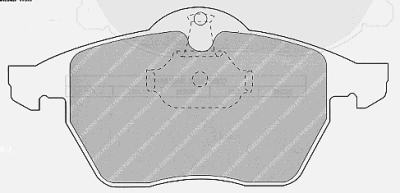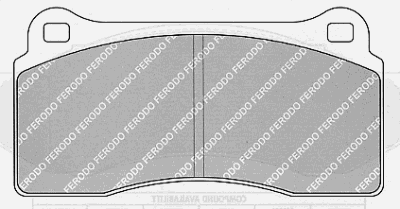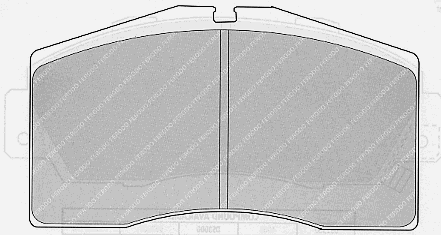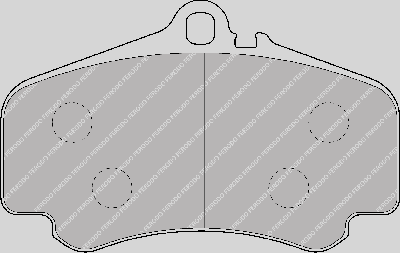Designing a performance brake system for the 9-3
Starting point:Saab 9-3 (ATE single piston caliper)
Dimensions 156,5 mm x 61 mm (effective surface is only 105 mm wide)
Ferrodo Pad No. FCP1068

308mm slotted Viggen disc
I. Using Brembo calipers
1. Ferrari F40 (Brembo four piston caliper) as used by Hirsch and MovIt
Ferrari Caliper No. 132.992 and 132.993
Pad Dimensions 131 mm x 51,5 mm
Ferrodo Pad No. FCP1281

Hirsch Performance disc 332x28mm made by Brembo
The Ferrari F40 has 330mm front discs, so the Hirsch 332mm disc is perfectly in line with the caliper. This is the setup supplied by Hirsch.
2. Porsche 993 biturbo (Brembo "big red" four piston caliper) as used by MovIt and Ring Racing
Porsche Caliper No. 993.351.425 and 993.351.426
Pad Dimensions 131,8 mm x 66 mm, effective surface 75,5 cm^2 per pad
Ferrodo Pad No. FCP891

Porsche disc 322x32mm, Porsche No. 993.351.045 and 993.351.046
The Porsche 993 biturbo has 322mm front discs. The disc comes in two pieces, the bell and the disc itself. Therefore it can be adapted easily to fit many cars, the Saab 9-3 being just one amongst them.
An advantage of this disc is that the contact area of the disc is much wider than that of the Hirsch disc, allowing a larger pad size. (A bigger pad of the same compound in the same location as a smaller pad will not yield shorter stopping distances. The amount of pressure applied, pad friction coefficient, and the diameter on the rotor at which that pressure is applied, determine the torque reaction, or stopping force. A bigger pad does not apply more pressure, only the same pressure over a bigger area. Where the size of the pad matters is in terms of heat capacity and wear rate. A larger pad will absorb more initial heat - less thermal shock - and have better wear characteristics, resulting in a longer pad life).
The disc is 32mm thick and therefore has much more heat capacity than the Hirsch disc.
Of course, brake torque (being the product of the force exerted by the caliper and the effective radius of the system) might be a little higher using the Hirsch disc because of itīs 3% larger effective radius.
Another disadvantage of the Porsche disc is that it is cross drilled. This means it is a little lighter, but also prone to cracking under heavy use (track days). Also, drilled discs tend to cause higher wear on the pads.
This is the setup supplied by MovIt and Ring Racing/BSP.
3. Porsche 996 GT3 (Brembo four piston aluminium-monobloc caliper)
Porsche Caliper No. 996.351.429 and 996.351.430
Pad Dimensions 140 mm x 59 mm, effective surface 76,5 cm^2 per pad
Ferrodo Pad No. FRP3050

The pad surface of the 996 GT3 aluminium monobloc caliper is 1,3% larger than that of the 993 biturbo caliper, but the main advantage of the monobloc is that it is lighter and stronger than the older two piece unit. This caliper is also used on the brand new 997 Carrera S.
a. Hirsch Performance disc 332x28mm made by Brembo
The early Porsche 996 GT3 has 330x34mm front discs, so the Hirsch 332x28mm disc should in theory be a perfect fit.
In practice, the problem is that the contact area of the Hirsch disc is less than 50 mm wide, while the surface of the GT3 pad is more than 50 mm wide. So the pad has to be modified to fit the disc.
Another problem might arise when the pads are worn down: The Hirsch disc is 6mm narrower than the GT3 disc, so the pads can get lose when worn down.
b. Porsche disc 322x32mm, Porsche No. 993.351.045 and 993.351.046
This is the 993 biturbo disc. It comes in two pieces, the bell and the disc itself. Therefore it can be adapted easily to fit many cars, the Saab 9-3 being just one amongst them. I installed this disc in august 2005 after having used the Hirsch disc for more than three months and 6.000 km, and it works like a treat, much better than the Hirsch disc: The better heat capacity really showed on the Hockenheimring!
c. Porsche disc 330x34mm
This is the 996 GT3 disc. It is a single-piece disc, but it is possible to get a blank disc (without pre-drilled bolt pattern) and to drill a 5x110 Saab bolt pattern. However, the bells of the 330mm disc are very deep, which would result in a much wider track (at least 25mm more on every side, resulting in 50mm for the front axle). This would make it necessary to modify the wheel arches or to find special rims.
II. using AP racing calipers
AP racing brake components are also a popular choice amongst Saab tuners: Abbott base their high end brake update on AP racing calipers and discs, and Nordic also supplies some AP racing based brake systems. AP racing discs have a very good reputation.
The CP5200 seams to be the most popular AP racing caliper. It has a two piece aluminum body and differential bores, just like the Porsche 993 biturbo caliper. The caliper can be used with disc sizes between 315 and 330 mm.
The pad area, however, is quite small: Dimensions of 132,3 x 50,3 mm give a surface of only 57,4 cm^2, which is only marginally more than the Saab standard pad.
There are also 6 and 8 pot calipers available from AP racing, but they need even larger discs, and the pads have the same radial depth.
All AP racing discs are two piece and can be adapted easily to fit many cars, the Saab 9-3 being just one amongst them. The sizes of choice for our application are 330x28mm and 330x32mm. As already mentioned, the discs have a very good reputation, so it is a shame that they cannot be used in conjunction with Porsche 993 biturbo or 996 GT3 calipers because radial depth is too small (the discs contact area is only up to 56mm wide).
Because the pad of the CP5200 is only 50 mm wide, the remaining 6mm of the discīs contact area tend to rust, which does not look nice.
III. Fitting instructions
Because it was requested by many readers of this page, I compiled a step-by-step tutorial on replacing the various components of the front brakes. You can find it here.
IV. Useful links
© 2005 - Philip Schneider
Design - Chris Deutsch
